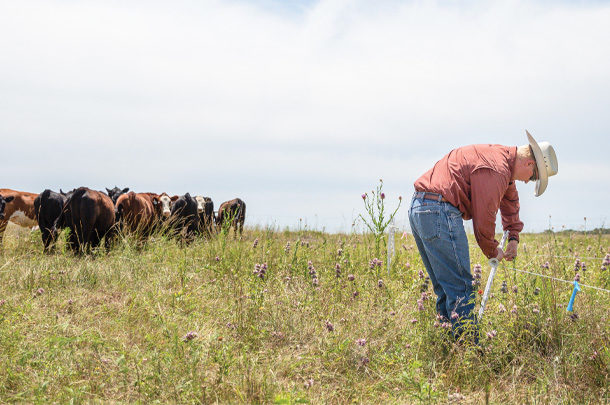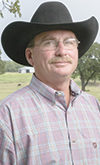Typically, when technology is mentioned in an agricultural setting, producers’ thoughts turn to GPS-guided tractors, digital ultrasound equipment or record-keeping software and hardware.
However, let’s look back almost 100 years ago when the first electric fence energizer and electric fencing were introduced to the agricultural world.
Now before you stop reading, please understand this article is not about how to construct or design an electric fencing system. If you are interested in finding information on how to build electric fence, you might start with this Noble Research Institute article).
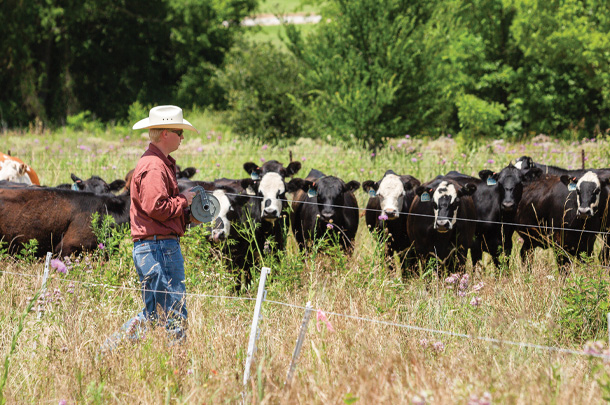
Richard Duncan, a Lloyd Noble summer scholar in agriculture, keeps a close eye on time as he moves cattle from one paddock to the next as part of a mob-grazing study.
When land was fenced a century ago, producers traditionally dug holes for both line posts and corner posts by hand, and strung as much barbed wire as they could afford. They built not only their perimeter fence but also fences to protect crops or cross fences on their land in this labor-intensive and costly fashion. With the invention of the electric energizer, producers were able to more economically install cross fences to divide pastures or fence out cropland.
Technology advances
Today, the energizers have become more powerful, with an effective pulse over longer distances and the ability to have multiple fences tied in series. Energizers come in several different sizes and can use different sources of power, such as solar, battery or a 110-volt power supply. With the wide range of power sources available, today’s energizers are suited for even the most remote locations.
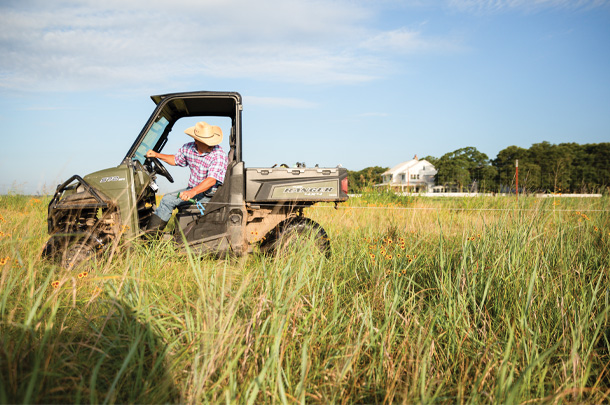
Paul Luna moves hot fences, a mineral feeder, water tank and 56 steers from one pasture to the next as part of AMP grazing methods, after carefully calculating the stocking rate based on measurements that use forage height, cattle weight and number of head, near the farmhouse at Noble Research Institute in Ardmore, Oklahoma.
Other fencing components have improved as well. Posts come in various shapes, sizes and materials for different uses, including “tread-in” or “step-in” line posts. The wire used in electric fencing has improved as well. The high-tensile wire used in today’s fencing systems makes an excellent electrified fence to string alongside a boundary fence to prevent animals, especially bulls, from continuously tearing down permanent barbed wire fences. Polywire braids, found in many brands and thicknesses, are excellent for temporary cross-fencing of existing pastures.
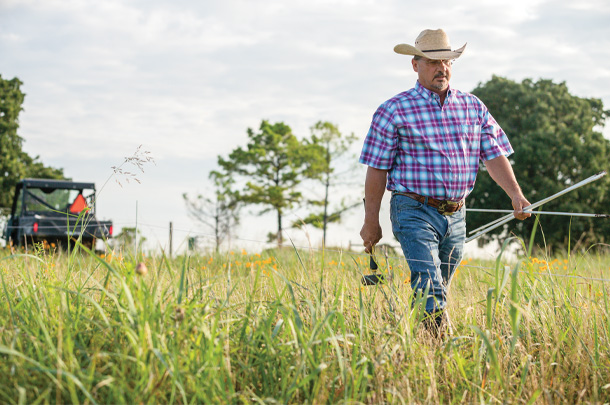
Paul Luna moves hot fences, a mineral feeder, water tank and 56 steers from one pasture to the next as part of AMP grazing methods, after carefully calculating the stocking rate based on measurements that use forage height, cattle weight and number of head, near the farmhouse at Noble Research Institute in Ardmore, Oklahoma.
Shutoff switches have historically been used to allow a producer the ability to disconnect power for specific sections of fence to allow for maintenance or repair. Some of today’s chargers have the technology that will allow a producer to remotely turn power to the energizer off and on from anywhere along the fencing system. This saves time by allowing the user to first find the problem and then turn the energizer off remotely without having to backtrack to the nearest shutoff switch.
A boon for regenerative grazing
Electric fencing is an added advantage to producers who are using or have started a regenerative grazing system for their operations. The portability of the temporary fence systems gives producers the adaptability to reconfigure pastures quickly and easily into smaller paddocks at different times in a grazing cycle. This is part of using ecological principles to improve the soil, forage, animal and water interactions within the interconnected ecosystem. By using the portable electric fencing, stock density (measured in total pounds of live weight per acre) can be fluctuated from a very light rate, fewer than 10,000 pounds per acre, for instance, to an extremely heavy rate of greater than 250,000 pounds.
Other advantages to using temporary electric fencing to create smaller paddocks include:
- Increased rest and recovery of grazed areas
- Increased animal impact through concentrating manure and urine distribution
- Animals grazing less desirable plants
- Reduced overgrazing
These tools are used within a regenerative rotational grazing plan and can be used to advance forage improvement and soil health. Plants need not only rest but time to recover as well. Rest can simply be defined as the number of days between grazing events, while recovery deals with regrowth of the root structure and plant leaves. Plants need to be fully recovered from a previous grazing event before they are grazed again.
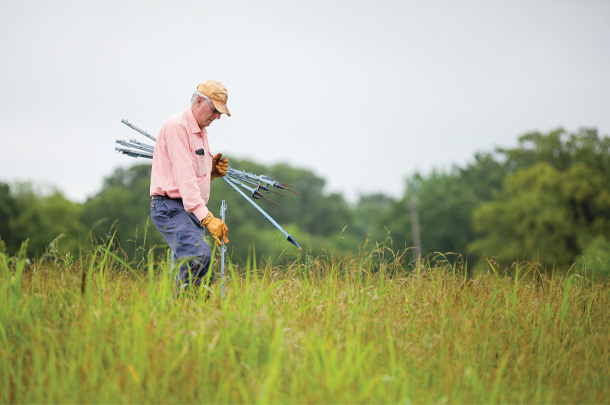
William and Karen Payne set up new hot-wire fencing on mixed-forage paddocks at Destiny Ranch in St. Louis, Oklahoma. William and Karen, who manage the 160 head of cows and calves on their own, pay close attention to the fencing they install and use only high-quality products they say will last up to 12 years. Staff photos by Rob Mattson/Noble Research Institute.
Often, producers will describe a pasture as being overgrazed when, in reality, only certain plants are overgrazed. Overgrazing of plants occurs when animals continually graze the same plant repeatedly without an opportunity for adequate rest and regrowth. Overgrazing of plants can happen in as few as seven days if animals are not moved to a new pasture or area.
Using temporary electric fencing, producers can concentrate animals in areas to take advantage of the animal impacts of hoof action and manure and urine concentration to help soil health. Hoof action is the “trampling” effect on the forage created by large numbers of animals in a small area. While it may look like forage has been wasted due to the trampling, it is actually beneficial. Trampled forage creates an increase in the biomass on top of the ground, helping to keep the soil cooler. Increased manure and urine concentration adds nutrients to the soil and encourages biological activity within the soil profile.
The future is virtual
Within the last decade or so, many companies, research institutes and universities have begun developing and field-testing technology to eliminate the need to string wire and drive posts for electric fencing. If you search the internet for “future of electric fencing,” you will find information regarding the various entities working on this improvement. As the future of electric fencing unfolds, producers potentially will be able to confine animals in specific areas using GPS “virtual fence” collars and transmitters without ever building another stretch of electric fence.
For now, using today’s electric fence technology saves producers time and allows them to manage and improve the financial and physical health of the resources under their care while gaining more flexibility in their operation. The technology of electric fencing has come a long way in the past hundred years; imagine how much further it will go in the next hundred. With continued technological advancements, ranchers will potentially have less physical fence to build and have more time available to concentrate on the other aspects of their operation.
